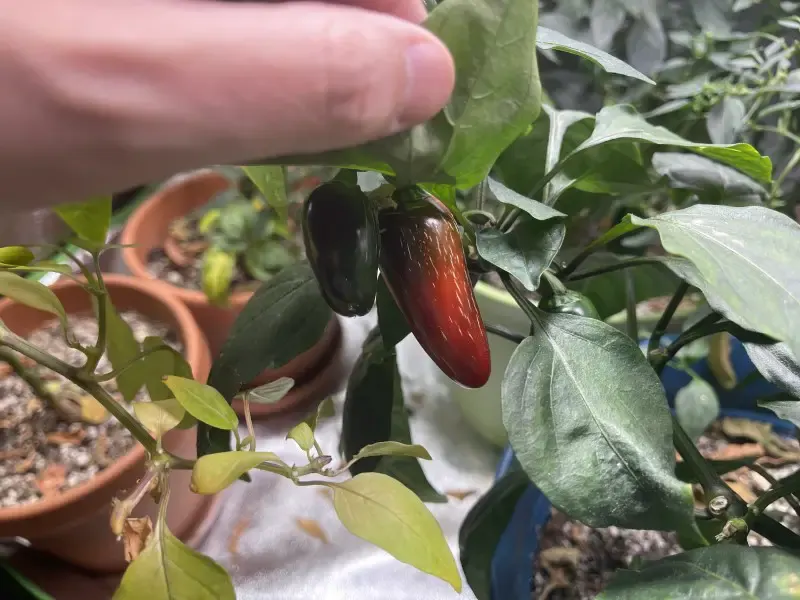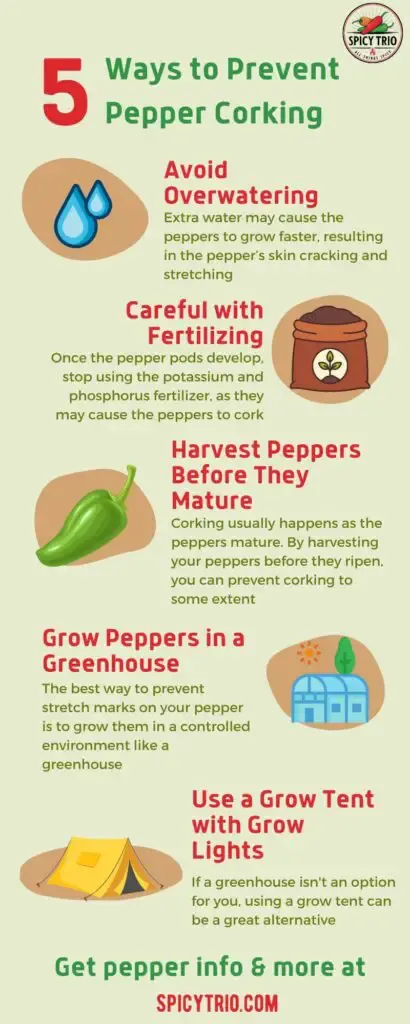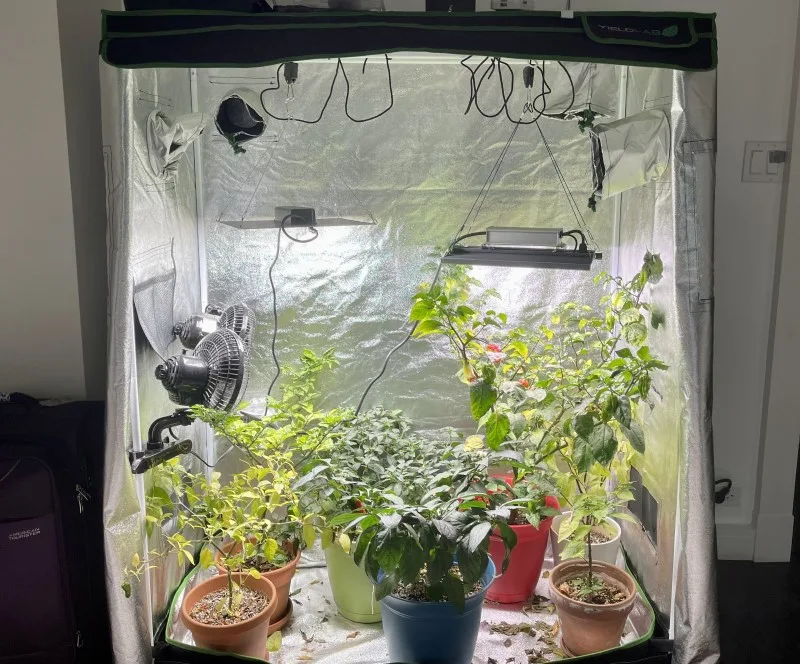Pepper corking is a common occurrence that pepper growers face, and results in slightly scarred or wrinkled peppers. While some people view corking as a problem, many consider it a sign that the pepper is good tasting and spicy! So, what is pepper corking, how do you prevent it, and should you prevent it?
Pepper corking refers to the scars and lines that may form on many types of pepper. While taste is not affected significantly, it can damage the aesthetic appeal of the peppers and may be a sign that the pepper plants are not getting enough nutrients or the growing conditions are not ideal.
The rest of this article will explore pepper corking in detail, what causes it and whether it affects the taste of your peppers. We’ll also give you some tips on how to prevent corking in pepper plants when growing them.

As an Amazon Associate, I earn from qualifying purchases.
What is Pepper Corking?
Pepper corking refers to the scars or white and brown lines that may appear on certain types of peppers. Corking happens when the pepper grows too fast in one direction, causing the skin to rip open and leave a scar. Pepper corking is a natural process yet it can also be caused by improper growing conditions.
In certain peppers, such as Jalapeños, the corking may take the shape of slightly wrinkled skin, especially if the pepper has soft skin. Corking can also result in white or brown lines on the pepper’s skin in other pepper types. In Jalapeños, corking usually appears after 50 days of planting, depending on the growing conditions.
While hot peppers like Jalapeños experience corking naturally, it doesn’t affect sweet peppers such as Bell peppers as often.
If you want to learn more, check out my article covering corking in Jalapenos peppers.
Even though pepper corking is natural, many people mistakenly take it for blemishes or a sign that the pepper is damaged. However, corked peppers can sometimes taste better than those with smooth skin, and can be a sign that the pepper is hot when it comes to spicy peppers. It’s also one of the signs that the pepper is ripe, and many pepper growers will harvest their peppers when the skin starts to cork.
Why Does Corking Happen in Peppers? What Causes It?
Corking happens naturally in peppers when nutrients and water are available before the pepper can absorb them. Pepper corking may be caused by heavy rains, adding soil fertilizer, or excess sunshine that causes the peppers to grow faster than usual, breaking the pepper’s skin.
However, it may also be caused by improper growing conditions. For instance, if you overwater the pepper plant in sunny weather, the pepper may experience a growth spurt, causing corking. As the pepper ripens, the corking will become more prominent, indicating that the pepper is ready for harvest.
Pepper corking may also be caused by an abundance of potassium and phosphorus fertilizer linked with the faster development of fruit and flowers. Using fertilizer high in phosphorus and potassium after the pepper plant flowers may cause corking. While nitrogen fertilizers affect the pepper plant, they won’t cause growth spurts in the pepper fruit.
So, while pepper corking does affect most pepper plants, it’s no reason for concern. In fact, pepper corking is entirely natural, and the lines that develop on the pepper may indicate if the pepper was ripe when picked.
How Else Can Pepper Corking Be Described?
Pepper corking can also be described as striations or stretch marks. These lines appear on peppers after the skin splits due to growth spurts. While pepper corking may be viewed as a blemish, it is nothing more than the effect of a growth spurt.
Even peppers growing naturally may experience corking after heavy rains, so there’s no need to view it as a blemish.
In fact, many vegetables experience a process that’s similar to corking. Squashes and pumpkins may split if they receive more water than usual when the fruit is developing. The same goes for other vegetables and vine plants such as watermelons.

Is It Okay To Eat Peppers That Have Corking?
It is okay to eat peppers that have corking. In fact, many peppers grown naturally will have corking, which is a sign that the pepper has received more rainfall and sunshine while the fruit is growing. There are no nutritional differences between peppers with corking and those without.
Unfortunately, many people see the lines and wrinkles as a sign of inferior or damaged peppers; sometimes, people may even mistake them for diseases. However, pepper corking is nothing more than a sign of a growth spurt, and peppers with these lines are exactly the same as smooth peppers.
Are Peppers That Have Corking Hotter?
While peppers with corking may not be popular among home cooks, many chefs and cooking enthusiasts prefer them because of their perceived bolder spice. Peppers with corking may be hotter, tastier, and prized in many countries and among chefs.
Peppers with corking are usually hotter because they have more time to mature on the vine. Corking becomes noticeable when the pepper pod matures on the vine. Many growers pick peppers before they mature to avoid corking, which may leave the pepper with less spice.
So, if you’re a consumer and are unsure whether to buy corked peppers, remember that they are more mature and may taste spicier than non-corked peppers. In fact, peppers with corking are prized in many South American countries due to their better flavors!
What Types of Peppers Tend To Have Corking?
Most varieties of hot peppers tend to have corking. Jalapeños are likely to have corking due to their faster growth, but chilis like Scotch Bonnets and Habaneros may also experience corking.
Sweet peppers such as green, red, and yellow Bell peppers don’t usually experience corking because of their larger fruit size and slower growth. Sometimes, Jalapeños will experience corking as they ripen, even if you don’t overwater them. However, peppers are less likely to experience corking in consistently drier weather.
5 Ways to Prevent Corking When Growing Peppers
While pepper corking isn’t necessarily bad, many growers prefer not to have it as customers view the lines and wrinkles as blemishes. If you prefer to have smooth peppers without corking, you can do a few things to accomplish this.
You can prevent corking when growing peppers in a controlled environment, such as a grow tent or greenhouse. Also, you should avoid overwatering the plant or adding too much fertilizer once the pods develop. Another way to prevent corking is to harvest peppers before they mature.

We’ll go in to more detail of each prevention method below.
Avoid Overwatering the Pepper Plants
Overwatering is the leading cause of corking in pepper plants. The extra water may cause the peppers to grow faster, resulting in the pepper’s skin cracking and stretching. Since peppers grow fast (some may mature in 50 days), giving them too much water after the pods have developed will cause corking.
Avoid Adding Too Much Fertilizer After the Pepper Pods Develop
Peppers are fast-growing plants and usually need more fertilizer when the plants are in the germination and early growth stages. Apply nitrogen, phosphorus, and potassium fertilizer before the pods develop to speed up the plant’s growth.
However, once the pods develop, stop using the potassium and phosphorus fertilizer, as they may cause the peppers to cork.
Harvest the Peppers Before They Mature
Corking usually happens as the peppers mature and the skin becomes slightly thicker. By harvesting your peppers before they ripen, you can prevent corking to some extent. While you may have smaller peppers, harvesting the peppers sooner will cause the plant to produce more peppers.
Grow Peppers in a Greenhouse
The best way to prevent stretch marks on your pepper is to grow them in a controlled environment like a greenhouse . This way you can control the amount of water the pepper plants get, and you won’t have to worry about corking. However, you’ll have to take care not to overwater the peppers as it may only cause them to get corked faster.
Pro tip: Besides being able to prevent corking, growing peppers in a greenhouse helps prevent pest infestations and will accelerate the plant’s growth.

Use a Grow Tent with Grow Lights
If you can’t afford to construct a greenhouse or don’t have space for it, using a grow tent can be an alternate option. Grow tents and grow lights allow you to control the environment in which your peppers grow.
Grow tents are perfect for controlling the fruit formation of many plants, including peppers, and can help prevent corking.
Here are my favorite grow tents available on Amazon.com:
- Yield Lab 48” x 24” x 60” Reflective Grow Tent: This is the grow tent I use. I like it because it’s easy to leave the tent wide open, pinning the doors to the grow tents’ side. I do this to improve air circulation when growing my peppers.
- Mars Hydro Grow Tent: This grow tent comes with a sturdy metal frame and quality zippers and can handle grow lights and other equipment. It’s also a budget-friendly option, and the perfect grow tent for peppers.
- VivoSun Grow Tent: With a reliable, heavy-duty zipper and a thick canvas, this grow tent strikes the perfect balance between quality and price. You’ll also get a two-year warranty on the tent.
- Topo Lite Indoor Grow Tent: If you’re looking to grow premium quality peppers indoors, this is a great option. It has a solid aluminum frame, quality zipper, and a design that won’t leak much light, making it ideal for indoor growing.
Closing Thoughts
While many people see the lines and wrinkles on peppers as blemishes, they are a sign of mature and better-flavored peppers. Pepper corking is a natural process when the peppers are exposed to more sunlight and water than usual.
While it’s not a significant issue, you can prevent corking by controlling the environment in which the pepper is grown and avoid overwatering the pepper plants after the pods form.
